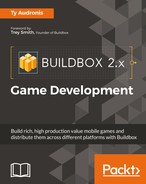Book Description
Build rich, high production value mobile games and distribute them across different platforms with Buildbox
About This Book
- Create captivating 2D & 2.5D (isometric) video games for all platforms
- Leverage Buildbox to monetize and prepare your games for distribution
- This step-by-step tutorial will get you generating complex and media rich games with no coding experience
Who This Book Is For
This book caters to those who have an interest or desire to create their own mobile games either as a hobbyist or who are looking to enhance their skills as a professional games developer. No coding experience is required.
What You Will Learn
- Create the illusion of a 3D background in your game using parallax
- Add advanced controls and obstacles to our first world
- Develop assets (graphic and audio) for the Buildbox engine
- Design games based on the capabilities and limitations of Buildbox and their target platforms
- Compile and distribute video games on various channels such as Steam, iOS store, Android stores, and the Mac App Store
- Optimize your games to get the absolute best quality within platform restrictions
- Conquer common issues experienced with Buildbox development
In Detail
Buildbox is an “any skill level” development platform to develop video games with no coding experience. It also exports these games to be compiled for any platform (from Windows to Mac to iOS to Android and Blackberry) all using the same graphic user interface.
Using an example as a tutorial, we will relate the driving principles and you’ll see how you can implement these principles to develop any games on the platform. We begin by setting expectations and providing a brief overview of the software. But it’s not long before you “dive in” to creating your first video game. You will actually have a playable level (“world”) by the end of the second chapter.
Later on, you’ll learn everything from basic graphics creation to advanced world design while you refine your first game, called “Ramblin’ Rover.” All along the way, you will see how certain functions could be used in tandem to create other types of games; hoping to spark imagination. We will follow the principles and process of monetization through ads and in-game rewards.
Lastly, we will go through the process of exporting, compiling, and preparing your storefront to sell the games you will eventually create.
Style and approach
This book follows a tutorial-based approach that teaches through examples, while also providing the necessary principles to enable you to abstract these principles into any game you want to make.
Downloading the example code for this book. You can download the example code files for all Packt books you have purchased from your account at http://www.PacktPub.com. If you purchased this book elsewhere, you can visit http://www.PacktPub.com/support and register to have the code file.
Table of Contents
- Buildbox 2.x Game Development
- Buildbox 2.x Game Development
- Credits
- Disclaimer
- Foreword
- About the Author
- About the Reviewer
- www.PacktPub.com
- Preface
- 1. So, You Want to Develop a Video Game?
- 2. Orientation
- 3. Your First Game – Ramblin' Rover, Part 1
- Keeping things organized
- Creating the game structure
- The initial Game Mind Map
- Placeholder objects and initial stage setup
- Preparing graphic assets for use in Buildbox
- Setting up our rover
- Creating our backgrounds
- Collisions and obstacles
- Working with scenes
- Setting up testing controls
- Testing and adjusting physics
- Adding a new scene
- Summary
- 4. Advanced World Design – Ramblin' Rover, Part 2
- 5. Menus, UIs, Sound, and More! – Ramblin' Rover, Part 3
- We got a fever, and the only cure is more rovers!
- Damage and health
- Creating a starting flag
- Organizing your scenes
- Menus and UIs
- Music and sound effects
- Summary
- 6. Monetization – Ramblin' Rover, Part 4
- 7. Exporting and Compiling for Various Platforms – Ramblin' Rover, Finale
- Optimizing game assets
- Signing up for distribution
- Finalizing project settings and exporting
- Exporting and compiling for Apple iOS
- Exporting and compiling for Google Play
- Exporting and compiling for Amazon App Store
- Exporting and compiling for the Windows store
- Exporting and compiling for Steam
- Compiling for Steam using Visual Studio
- Summary
- 8. Building Other Popular Game Types
- 9. Buildbox Tips and Tricks
